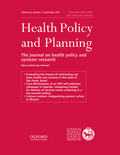Comparative cost analysis of insecticide-treated nets delivery strategies: sales supported by social marketing and free distribution through antenatal care, health policy and planning
De Allegri, Manuela / Paul Marschall / Steffen Flessa / Justin Tiendrebèogo / Bocar Kouyaté / lbrecht Jahn / Olaf MüllerExternal Publications (2010)
in: Health Policy Planning 25 (1), 28-38
Insecticide-treated nets (ITNs) are effective in substantially reducing malaria transmission. Still, ITN coverage in sub-Saharan Africa (SSA) remains extremely low. Policy makers are concerned with identifying the most suitable delivery mechanism to achieve rapid yet sustainable increases in ITN coverage. Little is known, however, on the comparative costs of alternative ITN distribution strategies. This paper aimed to fill this gap in knowledge by developing such a comparative cost analysis, looking at the cost per ITN distributed for two alternative interventions: subsidized sales supported by social marketing and free distribution to pregnant women through antenatal care (ANC). The study was conducted in rural Burkina Faso, where the two interventions were carried out alongside one another in 2006/07. Cost information was collected prospectively to derive both a financial analysis adopting a provider's perspective and an economic analysis adopting a societal perspective. The average financial cost per ITN distributed was US$8.08 and US$7.21 for sales supported by social marketing and free distribution through ANC, respectively. The average economic cost per ITN distributed was US$4.81 for both interventions. Contrary to common belief, costs did not differ substantially between the two interventions. Due to the district's ability to rely fully on the use of existing resources, financial costs associated with free ITN distribution through ANC were in fact even lower than those associated with the social marketing campaign. This represents an encouraging finding for SSA governments and points to the possibility to invest in programmes to favour free ITN distribution through existing health facilities. Given restricted budgets, however, free distribution programmes are unlikely to be feasible.

